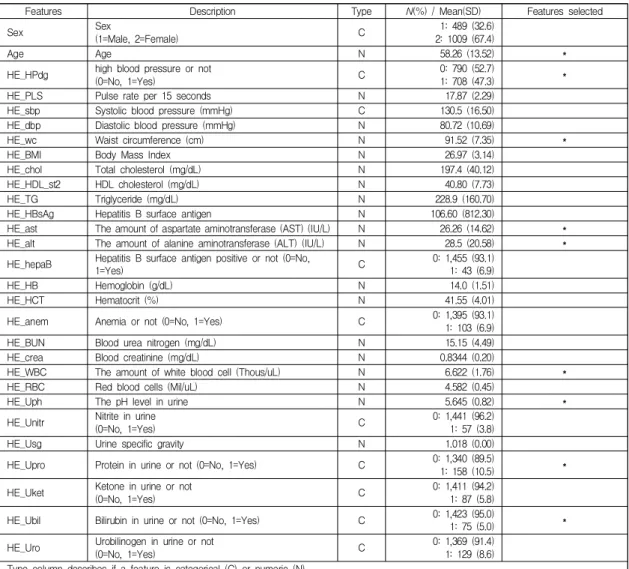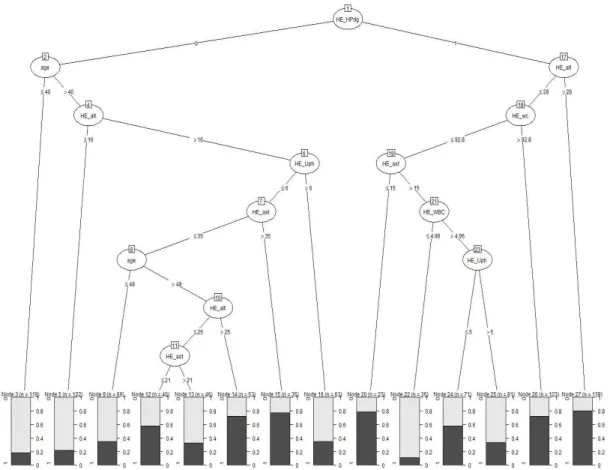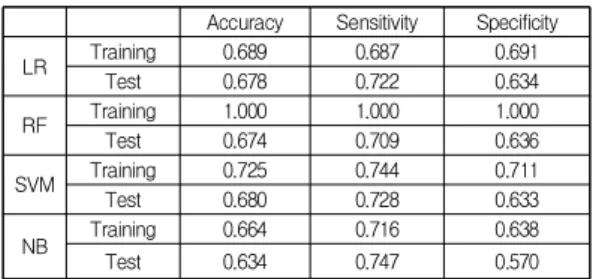1. Introduction
Metabolic Syndrome (MS) can be defined roughly as the cluster of risk factors for cardiovascular diseases such as stroke and diabetes [1]. Many researchers have attempted to identify characteristics of MS and
relationships to other diseases such as chronic kidney disease and fatty liver disease [2-4]. The main reason of their interest in MS is that it has been known as the cause of the incidence of diabetes [5]. Diabetes is not only the fatal disease which can lead to coronary heart disease, stroke and microvascular damage [6-8] but
Deriving rules for identifying diabetic among individuals with metabolic syndrome
Jinwook Choi
1, Yongmoo Suh
2*1
Business School, Korea University, Ph.D. candidate
2
Business School, Korea University, Professor
대사증후군 환자 가운데 당뇨환자를 찾기 위한 규칙 도출
최진욱1, 서용무2*
1고려대학교 경영학과 석박사과정, 2고려대학교 경영학과 교수
Abstract The objective of this study is to derive specific classification rules that could be used to prevent individuals with Metabolic Syndrome (MS) from developing diabetes. Specifically, we aim to identify rules which classify individuals with MS into those without diabetes (class 0) and those with diabetes (class 1). In this study we collected data from Korean National Health and Nutrition Examination Survey and built a decision tree after data pre-processing. The decision tree brings about five useful rules and their average classification accuracy is quite high (75.8%). In addition, the decision tree showed that high blood pressure and waist circumference are the most influential factors on the classification of the two groups. Our research results will serve as good guidelines for clinicians to provide better treatment for patients with MS, such that they do not develop diabetes.
Key Words : Data mining, Decision tree, Diabetes, Metabolic syndrome, KHANES
요 약 본 연구의 목적은 대사증후군이 당뇨병으로 확대되는 것을 방지하는데 이용할 수 있는 구체적인 분류 규칙을 도출 하는 것이다. 좀 더 구체적으로 말하면, 대사증후군을 앓고 있는 사람들을 당뇨병이 없는 사람 (class 0)과 당뇨병이 있는 사람(class 1)으로 구별해 내는 분류하는 규칙을 찾는 것이다. 본 연구는 국민건강영양조사 데이터를 수집하여 데이터 전처 리 과정들을 거친 후 의사결정나무를 구축하였다. 생성된 의사결정나무로부터 유용한 5개의 분류 규칙을 도출하였는데, 이들의 평균 분류 정확도는 75.8%이었다. 또한, 생성된 의사결정나무로부터 고혈압 여부와 허리둘레가 class 0 그룹과 class 1 그룹으로 분류하는데 있어서 중요한 요인임을 알 수 있었다. 이번 연구 결과는 의사들이 향후 대사증후군 환자가 당뇨 환자가 되지 않도록 치료하는데 좋은 지침이 될 것으로 기대된다.
주제어 : 데이터 마이닝, 의사결정나무, 당뇨병, 대사증후군, 국민건강영양조사
*This study is partially supported by Korea University Business School Research Grant.
*Corresponding Author : Yongmoo Suh(ymsuh@korea.ac.kr) Received August 16, 2018
Accepted November 20, 2018
Revised October 16, 2018 Published November 28, 2018



